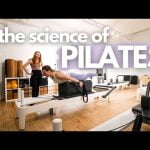Reform Equipment Pilates is a variation of traditional Pilates that utilizes specialized equipment to enhance the effectiveness and efficiency of the exercises. In this comprehensive guide, we will explore the numerous benefits of Reform Equipment Pilates and provide insights into its incredible advantages for optimal well-being.
Table of Contents
Incredible Advantages of Reform Pilates for Optimal Well-being
Reform Equipment Pilates offers a wide range of benefits that contribute to overall well-being. Here are some of the key advantages:
1. Enhanced Core Strength and Stability
Reform Equipment Pilates focuses on strengthening the core muscles, including the abdominals, back, and pelvic floor. The resistance provided by the equipment helps to engage and activate these muscles more effectively, leading to improved core strength and stability.
2. Increased Flexibility and Range of Motion
The reformer machine used in Reform Pilates allows for a greater range of motion compared to traditional mat exercises. This increased range of motion helps to improve flexibility and joint mobility, enabling individuals to perform daily activities with ease and reducing the risk of injuries.
3. Improved Posture and Alignment
Using the reformer machine promotes proper alignment and posture during exercises. The equipment provides support and resistance, allowing individuals to maintain correct spinal alignment throughout the movements. This leads to improved posture and reduced strain on the spine.
4. Muscle Tone and Definition
Reform Equipment Pilates helps to sculpt and tone muscles throughout the body. The resistance provided by the equipment challenges the muscles, leading to increased muscle strength and definition. Regular practice of Reform Pilates can result in a lean and toned physique.
5. Injury Rehabilitation and Prevention
The controlled movements and low-impact nature of Reform Pilates make it an ideal form of exercise for injury rehabilitation and prevention. The equipment allows for gentle yet effective strengthening of the muscles and joints, aiding in the recovery process and reducing the risk of future injuries.
Reform Pilates: Unveiling the Truth Behind Its Effectiveness
There is a growing interest in Reform Pilates, and rightfully so. The effectiveness of this exercise method lies in its unique combination of equipment and targeted movements. By utilizing the reformer machine, Reform Pilates offers several advantages over traditional mat exercises, including:
1. Increased Resistance
The reformer machine provides adjustable resistance, allowing individuals to challenge themselves at various fitness levels. This added resistance helps to build strength and endurance more efficiently, resulting in quicker progress and noticeable results.
2. Greater Variability
Reform Equipment Pilates offers a wide range of exercises that can be modified to suit individual needs and goals. The reformer machine allows for endless variations, making workouts more engaging and preventing plateaus. This variability keeps the body guessing and ensures constant progression.
3. Targeted Muscle Activation
The design of the reformer machine enables precise targeting of specific muscle groups. By adjusting the equipment and body positioning, individuals can isolate and activate specific muscles, leading to more effective and efficient workouts. This targeted muscle activation helps to address muscular imbalances and promote overall symmetry.
Understanding the Contrast: Pilates vs. Reformed Pilates – Unveiling the Key Differences!
While Pilates and Reform Pilates share similarities, there are some key differences between the two:
1. Equipment Usage
Traditional Pilates primarily utilizes a mat, while Reform Pilates incorporates specialized equipment such as the reformer machine, Cadillac, and Wunda chair. The use of equipment in Reform Pilates adds resistance and variability to the exercises, enhancing their effectiveness.
2. Resistance Levels
In traditional Pilates, resistance is primarily provided by body weight. In contrast, Reform Pilates offers adjustable resistance through the reformer machine, allowing individuals to increase or decrease the intensity of the exercises based on their fitness level and goals.
3. Exercise Variations
While both forms of Pilates focus on core strength, flexibility, and body awareness, Reform Pilates offers a greater variety of exercise variations. The reformer machine allows for countless modifications and progressions, making workouts more dynamic and challenging.
Optimal Frequency for Reformer Pilates: How Often Should You Do It?
The optimal frequency for practicing Reform Equipment Pilates depends on individual goals, fitness level, and schedule. Here are some general guidelines to consider:
1. Beginner Level
For beginners, starting with 2-3 sessions per week is recommended. This frequency allows the body to adjust to the exercises and gradually build strength and endurance.
2. Intermediate Level
Once individuals have developed a foundation and are comfortable with the exercises, increasing the frequency to 3-4 sessions per week can help accelerate progress and maintain momentum.
3. Advanced Level
Advanced practitioners can aim for 4-5 sessions per week to further challenge their bodies and continue pushing their limits. However, it’s crucial to listen to your body and allow for adequate rest and recovery.














